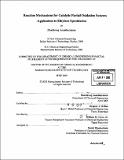| dc.contributor.advisor | Gregory J. McRae and William H. Green, Jr. | en_US |
| dc.contributor.author | Anantharaman, Bharthwaj | en_US |
| dc.contributor.other | Massachusetts Institute of Technology. Dept. of Chemical Engineering. | en_US |
| dc.date.accessioned | 2006-03-29T18:34:37Z | |
| dc.date.available | 2006-03-29T18:34:37Z | |
| dc.date.copyright | 2005 | en_US |
| dc.date.issued | 2005 | en_US |
| dc.identifier.uri | http://hdl.handle.net/1721.1/32328 | |
| dc.description | Thesis (Ph. D.)--Massachusetts Institute of Technology, Dept. of Chemical Engineering, 2005. | en_US |
| dc.description | Includes bibliographical references. | en_US |
| dc.description.abstract | With the rapid advances in kinetic modeling, building elementary surface mechanisms have become vital to understand the complex chemistry for catalytic partial oxidation systems. Given that there is selected experimental knowledge on surface species and a large number of unknown thermochemical, rate parameters, the challenge is to integrate the knowledge to identify all the important species and accurately estimate the parameters to build a detailed surface mechanism. This thesis presents computational methodology for quickly calculating thermodynamically consistent temperature/coverage-dependent heats of formation, heat capacities and entropies, correction approach for improving accuracy in heats of formation predicted by composite G3- based quantum chemistry methods, and detailed surface mechanism for explaining selectivity in ethylene epoxidation. Basis of the computational methodology is the Unity Bond Index- Quadratic Exponential Potential (UBI-QEP) approach, which applies quadratic exponential potential to model interaction energies between atoms and additive pairwise energies to compute total energy of an adsorbed molecule. By minimizing the total energy subject to bond order constraint, formulas for chemisorption enthalpies have been derived for surface species bound to on-top, hollow and bridge coordination sites with symmetric, asymmetric and chelating coordination structures on transition metal catalysts. The UBI-QEP theory for diatomics has been extended for polyatomic adsorbates with empirical modifications to the theory. | en_US |
| dc.description.abstract | (cont.) Formulas for activation energies have been derived for generic reaction types, including simple adsorption, dissociation-recombination, and disproportionation reactions. Basis of the correction approach is the Bond Additivity Correction (BAC) procedures, which apply atomic, molecular and bond- wise modifications to enthalpies of molecules predicted by G3B3 and G3MP2B3 composite quantum chemistry methods available in Gaussian® suite of programs. The new procedures have improved the accuracy of thermochemical properties for open and closed shell molecules containing various chemical moieties, multireference configurations, isomers and degrees of saturation involving elements from first 3 rows of the periodic table. The detailed mechanism explains the selectivity to ethylene oxide based on the parallel branching reactions of surface oxametallacycle to epoxide and acetaldehyde. Using Decomposition Tree Approach, surface reactions and species have been generated to develop a comprehensive mechanism for epoxidation. As a result of these developments in the thesis, chemisorption enthalpies can now be estimated within 3 kcal/mol of experimental values for transition metal catalysts and enthalpies predicted by G3B3 and G3MP2B3 Gaussian methods can be corrected within 0.5 kcal/mol. Examples of heterogeneous reaction systems involving silver-catalyzed ethylene epoxidation demonstrate the effectiveness of the methodologies developed in this work. | en_US |
| dc.description.statementofresponsibility | by Bharthwaj Anantharaman. | en_US |
| dc.format.extent | 395 p. | en_US |
| dc.format.extent | 18307999 bytes | |
| dc.format.extent | 18337207 bytes | |
| dc.format.mimetype | application/pdf | |
| dc.format.mimetype | application/pdf | |
| dc.language.iso | eng | en_US |
| dc.publisher | Massachusetts Institute of Technology | en_US |
| dc.rights | M.I.T. theses are protected by copyright. They may be viewed from this source for any purpose, but reproduction or distribution in any format is prohibited without written permission. See provided URL for inquiries about permission. | en_US |
| dc.rights.uri | http://dspace.mit.edu/handle/1721.1/7582 | |
| dc.subject | Chemical Engineering. | en_US |
| dc.title | Reaction mechanisms for catalytic partial oxidation systems : application to ethylene epoxidation | en_US |
| dc.type | Thesis | en_US |
| dc.description.degree | Ph.D. | en_US |
| dc.contributor.department | Massachusetts Institute of Technology. Department of Chemical Engineering | |
| dc.identifier.oclc | 61369133 | en_US |
